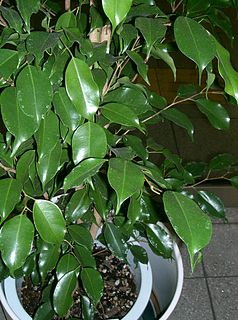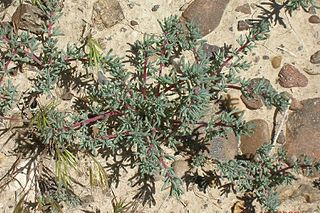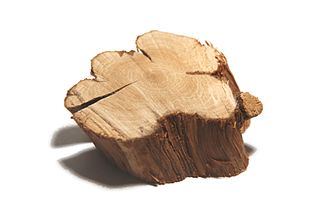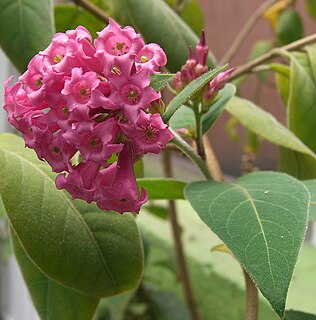
In botany, a bud is an undeveloped or embryonic shoot and normally occurs in the axil of a leaf or at the tip of a stem. Once formed, a bud may remain for some time in a dormant condition, or it may form a shoot immediately. Buds may be specialized to develop flowers or short shoots, or may have the potential for general shoot development. The term bud is also used in zoology, where it refers to an outgrowth from the body which can develop into a new individual.

Ficus benjamina, commonly known as weeping fig, benjamin fig or ficus tree, and often sold in stores as just ficus, is a species of flowering plant in the family Moraceae, native to Asia and Australia. It is the official tree of Bangkok. A recently described variety, Ficus benjamina var. Bracteata is found in uplifted coral forests of southern Taiwan. The species is also naturalized in the West Indies and in the states of Florida and Arizona in the United States. In its native range, its small fruit are favored by some birds, such as the superb fruit dove, wompoo fruit dove, pink-spotted fruit dove, ornate fruit dove, orange-bellied fruit dove, Torresian imperial pigeon, and purple-tailed imperial pigeon.

Waratah (Telopea) is an Australian-endemic genus of five species of large shrubs or small trees, native to the southeastern parts of Australia. The most well-known species in this genus is Telopea speciosissima, which has bright red flowers and is the NSW state emblem. The Waratah is a member of the plant family Proteaceae, a family of flowering plants distributed in the Southern Hemisphere. The key diagnostic feature of Proteaceae is the inflorescence, which is often very large, brightly coloured and showy, consisting of many small flowers densely packed into a compact head or spike. Species of waratah boast such inflorescences ranging from 6–15 cm in diameter with a basal ring of coloured bracts. The leaves are spirally arranged, 10–20 cm long and 2–3 cm broad with entire or serrated margins. The name waratah comes from the Eora Aboriginal people, the original inhabitants of the Sydney area.

The tamarillo is a small tree or shrub in the flowering plant family Solanaceae. It is best known as the species that bears the tamarillo, an egg-shaped edible fruit. It is also known as the tree tomato, tomate de árbol, tomate andino, tomate serrano, blood fruit, tomate de yuca, tomate de españa, sachatomate, berenjena and tamamoro in South America, and terong Belanda in Indonesia. They are popular globally, especially in Peru, Colombia, New Zealand, Ecuador, Rwanda, Australia, and the United States.

This article presents common techniques and facts regarding the cultivation of cannabis, primarily for the production and consumption of its infructescences. Cultivation techniques for other purposes differ.

Layering has evolved as a common means of vegetative propagation of numerous species in natural environments. Layering is also utilized by horticulturists to propagate desirable plants.

Halogeton glomeratus is a species of flowering plant in the family Amaranthaceae known by the common names saltlover, Aral barilla, and halogeton. It is native to Russia, Central Asia and China, but the plant is probably better known in the western United States, where it is an introduced species and a notorious noxious weed. This annual herb is a hardy halophyte, thriving in soils far too saline to support many other plants. It also grows in alkali soils such as those on alkali flats and disturbed, barren habitat. It can be found in sagebrush and shadscale habitat, and it grows well in areas with cold winters.

In botany, a rosette is a circular arrangement of leaves or of structures resembling leaves.

Aloidendron dichotomum, formerly Aloe dichotoma, the quiver tree or kokerboom, is a tall, branching species of succulent plant, indigenous to Southern Africa, specifically in the Northern Cape region of South Africa, and parts of Southern Namibia.
This page provides a glossary of plant morphology. Botanists and other biologists who study plant morphology use a number of different terms to classify and identify plant organs and parts that can be observed using no more than a handheld magnifying lens. This page provides help in understanding the numerous other pages describing plants by their various taxa. The accompanying page—Plant morphology—provides an overview of the science of the external form of plants. There is also an alphabetical list: Glossary of botanical terms. In contrast, this page deals with botanical terms in a systematic manner, with some illustrations, and organized by plant anatomy and function in plant physiology.
Important structures in plant development are buds, shoots, roots, leaves, and flowers; plants produce these tissues and structures throughout their life from meristems located at the tips of organs, or between mature tissues. Thus, a living plant always has embryonic tissues. By contrast, an animal embryo will very early produce all of the body parts that it will ever have in its life. When the animal is born, it has all its body parts and from that point will only grow larger and more mature. However, both plants and animals pass through a phylotypic stage that evolved independently and that causes a developmental constraint limiting morphological diversification.

A woody plant is a plant that produces wood as its structural tissue and thus has a hard stem. In cold climates, woody plants further survive winter or dry season above ground, as opposite to herbaceous plants that die back to the ground until spring.

Phalaenopsis bellina is a species of orchid endemic to Borneo. It is one of about 60 species the genus Phalaenopsis. Today it is one of the most commonly cultivated species in the genus.

Cestrum elegans, the purple cestrum, red cestrum, or bastard jasmine, is a species of flowering plants in the genus Cestrum.

A root trainer container is an aid to the cultivation of young plants and trees in nurseries. Many pot designs train the roots. One example is a truncated plastic cone in which a seedling is planted. There is a drainage hole at the bottom and the main tap root tends to grow towards this.

Bonsai cultivation and care involves the long-term cultivation of small trees in containers, called bonsai in the Japanese tradition of this art form. Similar practices exist in other Japanese art forms and in other cultures, including saikei (Japanese), penjing (Chinese), and hòn non bộ (Vietnamese). Trees are difficult to cultivate in containers, which restrict root growth, nutrition uptake, and resources for transpiration. In addition to the root constraints of containers, bonsai trunks, branches, and foliage are extensively shaped and manipulated to meet aesthetic goals. Specialized tools and techniques are used to protect the health and vigor of the subject tree. Over time, the artistic manipulation of small trees in containers has led to a number of cultivation and care approaches that successfully meet the practical and the artistic requirements of bonsai and similar traditions.

Crassula ovata, commonly known as jade plant, lucky plant, money plant or money tree, is a succulent plant with small pink or white flowers that is native to the KwaZulu-Natal and Eastern Cape provinces of South Africa, and Mozambique; it is common as a houseplant worldwide. Much of its popularity stems from the low levels of care needed; the jade plant requires little water and can survive in most indoor conditions. It is sometimes referred to as the money tree; however, Pachira aquatica also has this nickname.

Eccremocarpus scaber, the Chilean glory-flower or Chilean glory creeper, is a species of perennial plant in the Bignoniaceae family. It is found in Chile.

Protea angustata, also known as the Kleinmond sugarbush, is a flowering shrub that belongs to the genus Protea. This plant is endemic to the south-west Cape Region of South Africa.

















